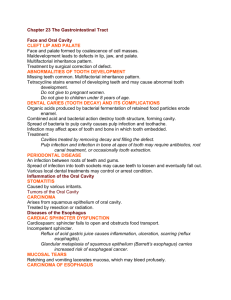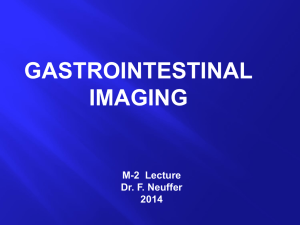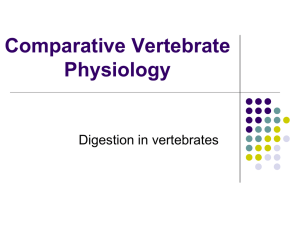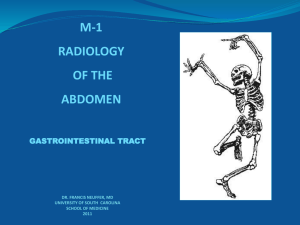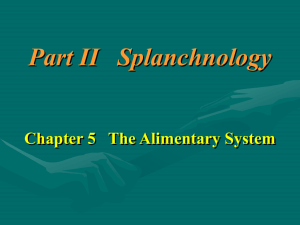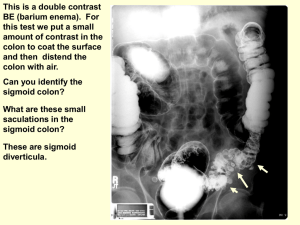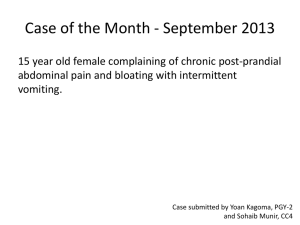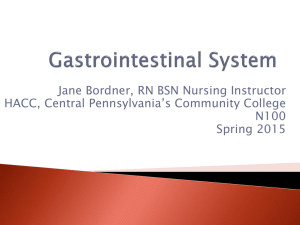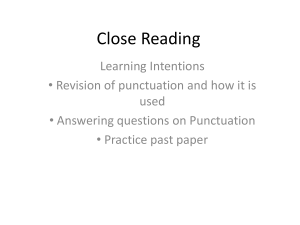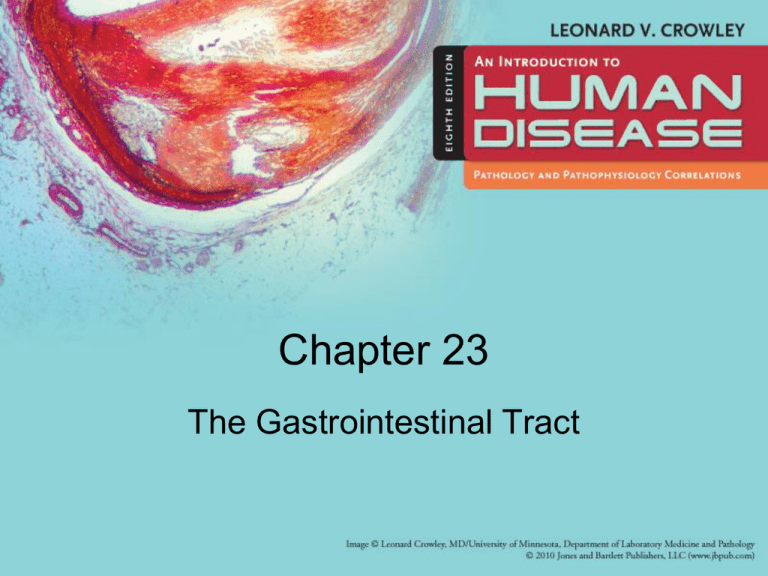
Chapter 23
The Gastrointestinal Tract
Learning Objectives (1 of 2)
• Identify major types of cleft lip and cleft palate
deformity
• Explain pathogenesis and prevention of dental
caries and periodontal disease
• Describe common congenital anomalies of the
GIT, clinical manifestations, diagnosis, treatment
• Describe three most common lesions of the
esophagus that lead to esophageal obstruction
• Explain pathogenesis, complications, and
treatment of peptic ulcer
• Describe types and clinical manifestations of acute
and chronic enteritis
Learning Objectives (2 of 2)
• Differentiate acute appendicitis and Meckel’s
diverticulitis in terms of pathogenesis, clinical
manifestations, and treatment
• Describe pathogenesis of diverticulitis and the
role of diet in its development
• Discuss causes, clinical manifestations,
complications
– Intestinal obstruction
– Colon cancer
– Diverticulosis
Gastrointestinal Tract
• Digestion and absorption of food
• Oral cavity
• Esophagus, stomach, small and large
intestines, anus
Cleft Lip and Cleft Palate
• Embryologically, face and palate formed by
coalescence of cell masses that merge to form
facial structures
• Palate formed by two masses of tissues that grow
medially and fuse at midline to separate as nose
and mouth
• Maldevelopment leads to defects
– 1 per 1000 births
– Multifactorial inheritance pattern
• Surgical correction (cheiloplasty)
– Cleft lip: soon after birth
– Cleft palate: 1 to 2 years of age followed by speech
therapy to correct nasal speech
Types of cleft lip and palate
abnormalities viewed from below
A complete bilateral cleft lip and cleft palate with
anterior protrusion of tissues between clefts
The same child at 18 months after
surgical correction of the defect
Abnormalities of Tooth
Development
• Teeth: specialized structures that develop in
tissues of the jaws
• Two sets
– Temporary or deciduous teeth (20 teeth)
– Permanent teeth (32 teeth)
• Missing teeth or extra teeth: common
abnormality
• Enamel forms at specific times during
embryologic period
• Tetracycline: administered during enamel
formation causes permanent yellow-gray to
brown discoloration of the crown
Incisors
Central (6–8 mo)
Lateral (8–10 mo)
Canine (eyetooth)
(16–20 mo)
Molars
First molar
(10–15 mo)
Second molar
(about 2 yr)
(a)
Deciduous
(milk) teeth
Incisors
Central (7 yr)
Lateral (8 yr)
Canine (eyetooth)
(11 yr)
Premolars
(bicuspids)
First premolar
(11 yr)
Second premolar
(12–13 yr)
Molars
First molar (6–7 yr)
Second molar
(12–13 yr)
Third molar
(wisdom tooth)
(17–25 yr)
Permanent
teeth
Figure 23.10a
Crown
Neck
Enamel
Dentin
Dentinal tubules
Pulp cavity (contains
blood vessels and
nerves)
Gingiva (gum)
Cementum
Root
Root canal
Periodontal
ligament
Apical foramen
Bone
Figure 23.11
Abnormalities of Tooth Development
Dental Caries and Periodontal
Disease
• Oral cavity: diverse collection of aerobic and anaerobic
bacteria that mix with saliva, forming sticky film on teeth
(dental plaque)
• Plaque + action of bacteria result in tooth decay (caries)
• Dental cavity: loss of tooth structure from bacterial action
• Gingivitis: inflammation of the gums due to masses of
bacteria and debris accumulating around base of teeth
• Periodontal disease: inflammation extends to tissues that
support teeth; forms small pockets of infection between
teeth and gums
– Two types: gingivitis and periodontitis
Tooth and Gum Disease
• Dental caries (cavities): gradual
demineralization of enamel and dentin
– Dental plaque (sugar, bacteria, and debris)
adheres to teeth
– Acid from bacteria dissolves calcium salts
– Proteolytic enzymes digest organic matter
– Prevention: daily flossing and brushing
Tooth and Gum Disease
• Gingivitis
– Plaque calcifies to form calculus (tartar)
– Calculus disrupts the seal between the
gingivae and the teeth
– Anaerobic bacteria infect gums
– Infection reversible if calculus removed
Tooth and Gum Disease
• Periodontitis
– Immune cells attack intruders and body
tissues
• Destroy periodontal ligament
• Activate osteoclasts
– Consequences
• Possible tooth loss, promotion of
atherosclerosis and clot formation in coronary
and cerebral arteries
Stomatitis
• Inflammation of the oral cavity
• Causes
– Irritants: alcohol, tobacco, hot or spicy foods
– Infectious agents: Herpes virus, Candida
albicans fungus, bacteria that cause trench
mouth
Carcinoma of the Oral Cavity
• Arises from squamous
epithelium
– Lips
– Cheek
– Tongue
– Palate
– Back of throat
Esophagus (1 of 3)
• Muscular tube that extends from pharynx to
stomach with sphincters at both upper and lower
ends
– Upper sphincter relaxes to allow passage of swallowed
food
– Lower (gastroesophageal or cardiac) sphincter relaxes
to allow passage of food to the stomach
• Diseases
– Failure of cardiac sphincter to function properly
– Tears in lining of esophagus from retching and vomiting
– At gastroesophageal junction from repetitive,
intermittent, vigorous contractions that increase
intraabdominal pressure
– Esophageal obstruction from carcinoma, food
impaction, or stricture
Bolus of food
Tongue
Uvula
Pharynx
Bolus
Epiglottis
Epiglottis
Glottis
Trachea
Bolus
Esophagus
1 Upper esophageal sphincter is
contracted. During the buccal phase, the
tongue presses against the hard palate,
forcing the food bolus into the oropharynx
where the involuntary phase begins.
Relaxed muscles
2 The uvula and larynx rise to prevent food
from entering respiratory passageways. The
tongue blocks off the mouth. The upper
esophageal sphincter relaxes, allowing food
to enter the esophagus.
4 Food is moved
through the esophagus
to the stomach by
peristalsis.
Circular muscles
contract
Bolus of food
3 The constrictor muscles of the
pharynx contract, forcing food
into the esophagus inferiorly. The
upper esophageal sphincter
contracts (closes) after entry.
Relaxed
muscles
5 The gastroesophageal
sphincter opens, and food
enters the stomach.
Longitudinal muscles
contract
Gastroesophageal
sphincter closed
Gastroesophageal
sphincter opens
Stomach
Figure 23.13
Relaxed muscles
Circular muscles
contract
4 Food is moved through
the esophagus to the
stomach by peristalsis.
Bolus of food
Longitudinal muscles
contract
Gastroesophageal
sphincter closed
Stomach
Figure 23.13, step 4
Esophagus (2 of 3)
• Symptoms
–
–
–
–
–
Difficulty swallowing (dysphagia)
Substernal discomfort or pain
Inability to swallow (complete obstruction)
Regurgitation of food into trachea
Choking and coughing
• Two major disturbances of cardiac sphincter
– 1. Cardiospasm: sphincter fails to open properly due to
malfunction of nerve plexus; esophagus becomes dilated
proximal to constricted sphincter from food retention
• Treatment: periodic stretching of sphincter; surgery
– 2. Incompetent cardiac sphincter: sphincter remains
open; gastric juices leak back into esophagus
Esophagus (3 of 3)
• Complications of incompetent cardiac sphincter
– Reflux esophagitis: inflammation
– Ulceration and scarring of squamous mucosal lining
– Barrett’s esophagus: glandular metaplasia; change from
squamous to columnar epithelium; ↑risk for cancer -a
disorder in which the lining of the esophagus is damaged
by stomach acid.
• Esophageal obstruction
– Carcinoma: can arise anywhere in esophagus
– Tumor narrows lumen of esophagus, infiltrates
surrounding tissue, invades trachea (tracheoesophageal
fistula)
– Food impaction: distal part
– Stricture: from scar tissue due to necrosis and
inflammation from corrosive chemicals such as lye
Gastric mucosal tear caused by
retching and vomiting
Mallory–Weiss syndrome or
gastro-esophageal laceration
syndrome refers to bleeding from
tears (a Mallory-Weiss tear) in the
mucosa at the junction of the
stomach and esophagus, usually
caused by severe retching,
coughing, or vomiting.
Liver
Gallbladder
Lesser omentum
Stomach
Duodenum
Transverse colon
Small intestine
Cecum
Urinary bladder
(b)
Figure 23.30b
Surface
epithelium
Mucosa
Lamina propria
Submucosa
(contains submucosal
plexus)
Muscularis externa
(contains myenteric
plexus)
Serosa
Muscularis
mucosae
Oblique layer
Circular layer
Longitudinal
layer
(a) Layers of the stomach wall (l.s.)
Stomach wall
Figure 23.15a
Gastric pits
Surface epithelium
(mucous cells)
Gastric
pit
Mucous neck cells
Parietal cell
Chief cell
Gastric
gland
Enteroendocrine cell
(b) Enlarged view of gastric pits and gastric glands
Figure 23.15b
Pepsinogen
HCl
Pepsin
Mitochondria
Parietal cell
Chief cell
Enteroendocrine
cell
(c) Location of the HCl-producing parietal cells and
pepsin-secreting chief cells in a gastric gland
Figure 23.15c
Blood
capillary
Chief cell
CO2
CO2 + H2O
Carbonic
H2CO3 anhydrase
H+
K+
Stomach lumen
H+-K+
ATPase
H+
K+
HCO3–
Alkaline
tide
HCI
Parietal cell
HCO3–
Cl–
Cl–
HCO3–- Cl–
antiporter
Cll–
Interstitial
fluid
Figure 23.18
Acute Gastritis
• Inflammation of the gastric lining
• Self-limited inflammation of short duration
• May be associated with mucosal ulceration or
bleeding
• From nonsteroidal anti-inflammatory drugs (NSAID)
that inhibit cyclooxygenase (COX) enzyme: aspirin,
ibuprofen, naproxen
– COX-1: promotes synthesis of prostaglandin that protects
gastric mucosa
– COX-2: promotes synthesis of prostaglandin that mediate
inflammation
• Drugs that selectively inhibit COX-2 increase risk for heart attack
and stroke
• Alcohol: a gastric irritant; stimulates gastric acid
secretion
H. Pylori Gastritis (1 of 2)
• Small, curved, gram-negative organisms that
colonize surface of gastric mucosa
• Grow within layer of mucus covering epithelial
cells
• Produce urease that decomposes urea, a
product of protein metabolism, into ammonia
• Ammonia neutralizes gastric acid allowing
organisms to flourish; organisms also produce
enzymes that break down mucus layer
H. Pylori Gastritis (2 of 2)
• Common infection that increases with age
(50% by age 50)
• Spreads via person-to-person through close
contact and fecal-oral route
• Increased risk of gastric carcinoma:
intestinal metaplasia
• Increased risk of malignant lymphoma
(mucosa-associated lymphoid tissue, MALT)
Bacteria
Mucosa
layer of
stomach
(a) A gastric ulcer lesion
(b) H. pylori bacteria
Figure 23.16
Peptic Ulcer
• Pathogenesis
– Digestion of mucosa due to increased acid secretions
and digestive enzymes (gastric acid and pepsin)
– Helicobacter pylori injures mucosa directly or through
increased acid secretion by gastric mucosa
– Common sites: distal stomach or proximal
duodenum
• Complications: hemorrhage, perforation,
peritonitis, obstruction from scarring
• Treatment
– Antacids: block acid secretion by gastric epithelial cells
– Antibiotic therapy: against H. pylori
– Surgery if medical therapy fails
Bacteria
Mucosa
layer of
stomach
(a) A gastric ulcer lesion
(b) H. pylori bacteria
Figure 23.16
Gastric ulcer, eroded a blood
vessel at base of ulcer causing
profuse bleeding
Large, chronic
duodenal ulcer
Carcinoma of the Stomach
• Manifestations
– Vague upper abdominal discomfort
– Iron-deficiency anemia (chronic blood loss
from ulcerated surface of tumor)
• Diagnosis: biopsy by means of
gastroscopy
• Treatment: surgical resection of affected
part, surrounding tissue and lymph nodes
• Long-term survival: relatively poor; often
far-advanced at time of diagnosis
Carcinoma of the Stomach
Inflammatory Diseases of the
Intestines
• Acute enteritis
– Intestinal infections; common; of short duration
– Nausea, vomiting, abdominal discomfort, loose stools
• Chronic enteritis: less common, more difficult to
treat
• Regional enteritis or Crohn’s disease: distal ileum
– Chronic inflammation and ulceration of mucosa with
thickening and scarring of bowel wall
– Inflammation may be scattered with normal intervening
areas or “skip areas”
– Treatment: drugs and possible surgical resection of
affected part of bowel
Ulcerative Colitis (1 of 2)
• Ulcerative colitis: large intestines and
rectum
– Inflammation is limited to mucosa, bowel not
thickened unlike in Crohn’s
– Frequently begins in rectal mucosa and
spreads until entire colon is involved
• Complications
– Bleeding; bloody diarrhea
– Perforation: from extensive inflammation with
leakage of intestinal contents into peritoneal
cavity
– Long-standing disease may develop cancer
of colon and/or rectum
Ulcerative Colitis (2 of 2)
• Treatment
– Symptomatic and supportive measures
– Antibiotics, corticosteroids to control flare-ups
– Immunosuppressive drugs
– Surgical resection
Inflammatory Diseases of the
Intestines (1 of 3)
• Antibiotic-associated colitis: broad-spectrum
antibiotics destroy normal intestinal flora
– Allows growth of anaerobic spore-forming bacteria,
Clostridium difficile not inhibited by antibiotic taken
– Organisms produce toxins causing inflammation and
necrosis of colonic mucosa
– Diarrhea, abdominal pain, fever
• Diagnosis: stool culture, toxin in stool
• Treatment: stop antibiotic treatment; give
vancomycin or metronidazole
– Drugs that decrease intestinal motility will prolong
illness
Inflammatory Diseases of the
Intestines (2 of 3)
• Appendicitis: most common inflammatory lesion
of the bowel
– Narrow caliber of appendix may be plugged with fecal
material
– Secretions of appendix drain poorly, create pressure
in appendiceal lumen, compressing blood supply
– Bacteria invade appendiceal wall causing
inflammation
• Manifestations
– Generalized abdominal pain localizing in right lower
quadrant; rebound tenderness; rigidity
• Treatment: surgery
Inflammatory Diseases of the
Intestines (3 of 3)
• Meckel’s diverticulum
– Outpouching at distal ileum, 12-18 inches proximal to
cecum
– From persistence of a remnant of the vitelline duct,
narrow tubular channel connecting small intestine with
yolk sac embryologically
– Found in 2% of population; usually asymptomatic
• May become infected causing features and
complications similar to acute appendicitis
• Lining may consist of ectopic acid-secreting
gastric mucosa and may cause peptic ulcer
Regional enteritis, mucosa ulcerated and
covered with inflammatory exudate
Inflammatory Disease Intestines
Disturbances in Bowel Function
(1 of 2)
• Food intolerance: Crampy abdominal pain,
distention, flatulence, loose stools
• Lactose intolerance
– Unable to digest lactose into glucose and galactose for
absorption due to lactase deficiency
– Enzyme abundant in infants and young children
– Unabsorbed lactose remains in intestinal lumen and
raises osmotic pressure of bowel contents
– Fermented by bacteria in colon, yielding lactic acid that
further increases intraluminal pressure
– Common in Asians; 90% in Native Americans; 70%
Blacks
Disturbances Bowel Function
(2 of 2)
• Gluten intolerance (Celiac disease; Gluten
enteropathy or Nontropical sprue)
– Gluten: protein in wheat, rye, barley; imparts
elasticity to bread dough
– Chronic diarrhea impairing absorption of fats and
nutrients; weight loss, vitamin deficiencies
– Leads to atrophy of intestinal villi
– Diagnosis: clinical features and biopsy of
intestinal mucosa
– Treatment: gluten-free diet
Irritable Bowel Syndrome
• Also known as spastic colitis or mucous colitis
• Episodes of crampy abdominal discomfort, loud
gurgling bowel sounds, and disturbed bowel function
without structural or biochemical abnormalities
• Alternating diarrhea and constipation
• Excessive mucus secreted by colonic mucosal
glands
• Diagnosis: by exclusion
– Rule out pathogenic infections, food intolerance, and
inflammatory conditions
• Treatment
– Reduce emotional tension
– Improve intestinal motility
Intestinal Infections in
Homosexual Men
•
•
•
•
•
•
Shigella
Salmonella
Entamoeba Histolytica
Giardia
Transmission: anal-oral sexual practices
Treatment: treat underlying cause
Colon Diverticulosis and
Diverticulitis
• Diverticulosis: outpouchings or diverticula of
colonic mucosa through weak areas in the
muscular wall of large intestine
– Low-residue diet predisposes to condition as increased
intraluminal pressure must be generated to propel stools
through colon
– Acquired, usually asymptomatic, seen in older people
– Common site: sigmoid colon
• Diverticulitis: inflammation incited by bits of fecal
material trapped within outpouchings
• Complications: inflammation, perforation, bleeding,
scarring, abscess
Diverticulosis of colon. Exterior of colon,
illustrating several diverticula projecting
through the wall of the colon.
Interior of colon, illustrating openings of
multiple diverticula
Diverticula of colon demonstrated by
injection of barlum contrast material into
colon (barium enema)
Intestinal Obstructions (1 of 5)
• Conditions blocking normal passage of
intestinal contents
• Always considered as a serious condition
• Severity depends on location of
obstruction, completeness, interference
with blood supply
• High intestinal obstruction
– Severe, crampy abdominal pain from
vigorous peristalsis
– Vomiting with loss of H2O and electrolytes,
may result in dehydration
Intestinal Obstructions (2 of 5)
• Low intestinal obstruction
– Symptoms less acute
– Mild, crampy abdominal pain
– Moderate distention of abdomen
• Common causes of intestinal obstruction
–
–
–
–
–
Adhesions
Hernia
Tumor
Volvulus
Intussusception
Intestinal Obstructions (3 of 5)
• Adhesions
– Adhesive bands of connective tissue
– May cause loop of bowel to become kinked,
compressed, twisted
– Causes obstruction proximal to site of
adhesion
• Hernia
– Protrusion of loop of bowel through a small
opening, usually in abdominal wall
– Herniated loop pushes through peritoneum
to form hernial sac
Intestinal Obstructions (4 of 5)
• Hernia
– Inguinal hernia: common in men; loop of small
bowel protrudes through a weak area in
inguinal ring and descends downward into
scrotum
– Umbilical and femoral hernia: common in both
sexes
• Umbilical hernia: loop of bowel protrudes into
umbilicus through defect in the abdominal wall
• Femoral hernia: loop of intestine extends under
inguinal ligament along course of femoral vessels
into the groin
Intestinal Obstructions (5 of 5)
• Reducible hernia: herniated loop of bowel can be
pushed back into abdominal cavity
• Incarcerated hernia: cannot be pushed back
• Strangulated hernia: loop of bowel is tightly
constricted obstructing the blood supply to the
herniated bowel; requires prompt surgical
intervention
• Volvulus: rotary twisting of bowel impairing blood
supply; common site: sigmoid colon
• Intussusception: telescoping of a segment of
bowel into adjacent segment; from vigorous
peristalsis or tumor
– Common site: terminal ileum
Fibrous adhesions between
a loop of small intestine and omentum
Umbilical hernia, infant
Inguinal hernia,
bilateral, extending
into scrotum
Intussusception resulting from a colon tumor
Volvulus
A. Rotary twisting of sigmoid colon on its mesentery
B. Obstruction of colon and interruption of blood supply
Mesenteric Thrombosis
• Thrombosis of superior mesenteric artery
– Artery supplies blood to small bowel and
proximal half of colon
– May develop arteriosclerosis
– Become occluded by thrombus, embolus, or
atheroma
– Obstruction causes extensive bowel infarction
Figure 19.23d
Tumors of the Colon
• Benign pedunculated polyps
– Frequent
– Tip may erode causing bleeding
– Removed by colonoscopy
• Carcinoma
– Cecum and right half of colon
• Does not cause obstruction as caliber is large and bowel
contents are relatively soft
• Tumor can ulcerate, bleed; leads to chronic iron-deficiency
anemia
• Symptoms of anemia: weakness and fatigue
– Left half of colon
• Causes obstruction and symptoms of lower intestinal
obstruction
Left colic
(splenic) flexure
Transverse
mesocolon
Epiploic
appendages
Right colic
(hepatic)
flexure
Transverse
colon
Superior
mesenteric
artery
Haustrum
Descending
colon
Ascending
colon
IIeum
Cut edge of
mesentery
Teniae coli
IIeocecal
valve
Cecum
Vermiform appendix
Sigmoid
colon
Rectum
Anal canal
(a)
External anal sphincter
Figure 23.29a
Colon Carcinoma
Imperforate Anus
• Congenital anomaly, colon fails to acquire a
normal anal opening
• Two types
• 1. Rectum and anus normally formed and
extends to level of skin but no anal orifice
– Easily treated by incising tissue covering anal opening
• 2. Entire distal rectum fails to develop, with
associated abnormalities of urogenital and
skeletal system
– Corrected surgically but technically more difficult
– Less satisfactory results
Imperforate Anus
Hemorrhoids
• Hemorrhoids are vascular structures in the anal canal
which help with stool control. They become pathological
when swollen or inflamed. In their physiological state they
act as a cushion composed of arterio-venous channels and
connective tissue that aid the passage of stool. The
symptoms of pathological hemorrhoids depend on the type
present. Internal hemorrhoids usually present with painless
rectal bleeding while external hemorrhoids present with pain
in the area of the anus.
• Recommended treatment consists of increasing fiber intake,
oral fluids to maintain hydration, NSAID analgesics, sitz
baths, and rest. Surgery is reserved for those who fail to
improve following these measures.
Rectal valve
Rectum
Hemorrhoidal
veins
Levator ani
muscle
Anal canal
External anal
sphincter
Internal anal
sphincter
Anal columns
Pectinate line
Anal sinuses
Anus
(b)
Figure 23.29b
Figure 19.28a
Figure 19.28c
Rectal valve
Rectum
Hemorrhoidal
veins
Levator ani
muscle
Anal canal
External anal
sphincter
Internal anal
sphincter
Anal columns
Pectinate line
Anal sinuses
Anus
(b)
Figure 23.29b
Hemorrhoids
• Varicose veins of hemorrhoidal venous plexus that
drains rectum and anus
• Constipation and straining predispose to
development
• Relieved by high-fiber diet rich in fruits and
vegetables, stool softeners, rectal ointment, or
surgery
– Internal hemorrhoids
• Veins of the lower rectum
• May erode and bleed, become thrombosed, or prolapse
– External hemorrhoids
• Veins of anal canal and perianal skin
• May become thrombosed, causing discomfort
Diagnosis of GI Disease
• Endoscopic procedures
– To directly visualize and biopsy abnormal areas
such as esophagus, stomach, intestines
• Radiologic examination
– To examine areas that cannot be readily
visualized
– To evaluate motility problems
– To visualize contours of GIT mucosa
– To identify location and extent of disease
• Examples: Upper gastrointestinal tract – UGI
• Colon – BE (barium enema)
Duodenum – 10 inches
Jejunum – 8 feet
Ileum – 12 feet
Large Intestine – 4.9 feet
Barium
Barium Swallow
Barium Enema
Colon carcinoma demonstrated by barium enema
Discussion
• A 45-year-old patient has a large right-sided
colon carcinoma with iron deficiency anemia.
The anemia is most likely due to:
– A. Impaired absorption of nutrients due to the
tumor
– B. Chronic blood loss from ulcerated surface of
the tumor
– C. Poor appetite
– D. Metastases to the liver
– E. Obstruction of the colon by the tumor

